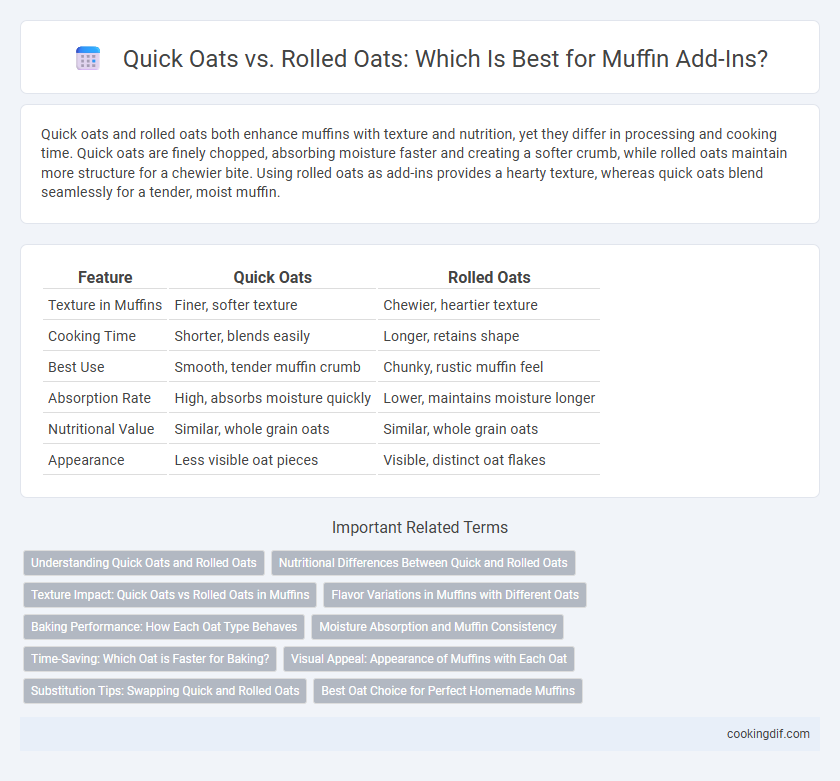Quick oats and rolled oats both enhance muffins with texture and nutrition, yet they differ in processing and cooking time. Quick oats are finely chopped, absorbing moisture faster and creating a softer crumb, while rolled oats maintain more structure for a chewier bite. Using rolled oats as add-ins provides a hearty texture, whereas quick oats blend seamlessly for a tender, moist muffin.
Table of Comparison
| Feature | Quick Oats | Rolled Oats |
|---|---|---|
| Texture in Muffins | Finer, softer texture | Chewier, heartier texture |
| Cooking Time | Shorter, blends easily | Longer, retains shape |
| Best Use | Smooth, tender muffin crumb | Chunky, rustic muffin feel |
| Absorption Rate | High, absorbs moisture quickly | Lower, maintains moisture longer |
| Nutritional Value | Similar, whole grain oats | Similar, whole grain oats |
| Appearance | Less visible oat pieces | Visible, distinct oat flakes |
Understanding Quick Oats and Rolled Oats
Quick oats are processed by cutting oats into smaller pieces and steaming them, which allows for faster cooking and a softer texture in muffins, making them ideal for a tender crumb. Rolled oats are steamed and then flattened whole oat groats, providing a chewier texture and more defined oat flavor that adds a rustic touch to muffin add-ins. Choosing between quick oats and rolled oats affects the muffin's moisture retention, texture, and overall mouthfeel during baking.
Nutritional Differences Between Quick and Rolled Oats
Quick oats and rolled oats differ slightly in nutritional profile, with rolled oats typically retaining more fiber and protein due to less processing. Both types offer essential nutrients like iron, magnesium, and B vitamins, but rolled oats maintain a lower glycemic index, promoting steadier blood sugar levels. Incorporating rolled oats into muffin recipes enhances texture and nutritional value, while quick oats provide a softer consistency with marginally faster digestion.
Texture Impact: Quick Oats vs Rolled Oats in Muffins
Quick oats create a softer, more uniform texture in muffins due to their finer cut and faster cooking time, which helps them blend seamlessly into the batter. Rolled oats, being larger and less processed, provide a chewier, heartier texture, adding noticeable bite and rustic appeal to the muffin crumb. Choosing between quick oats and rolled oats impacts the overall mouthfeel, with quick oats favoring moistness and softness while rolled oats enhance chewiness and visual oat presence.
Flavor Variations in Muffins with Different Oats
Quick oats offer a finer texture and milder flavor, blending seamlessly into muffin batter for a subtle oat presence. Rolled oats provide a chewier bite with a nuttier, more pronounced oat flavor that enhances the muffin's overall texture and taste. Choosing between quick and rolled oats influences the muffin's flavor profile and mouthfeel, allowing for tailored variations from tender and smooth to hearty and robust.
Baking Performance: How Each Oat Type Behaves
Quick oats absorb moisture faster and create a softer, denser muffin crumb, enhancing tenderness but reducing structural integrity. Rolled oats retain more texture during baking, providing a chewier, heartier bite and improving muffin stability. Choosing between quick and rolled oats impacts moisture retention, crumb texture, and overall muffin consistency.
Moisture Absorption and Muffin Consistency
Quick oats absorb moisture faster than rolled oats, leading to a denser muffin crumb and a slightly chewier texture. Rolled oats retain more structure during baking, providing a fluffier consistency while still contributing hearty oat flavor. Selecting rolled oats for muffin add-ins enhances moisture retention without compromising overall softness and tenderness.
Time-Saving: Which Oat is Faster for Baking?
Quick oats absorb moisture and bake faster than rolled oats, making them ideal for muffin add-ins when time-saving is a priority. Their thinner, smaller flakes require less cooking time, ensuring quicker batter preparation and a softer muffin texture. Rolled oats, while providing a chewier consistency, need longer baking times to fully soften.
Visual Appeal: Appearance of Muffins with Each Oat
Quick oats create a denser and more uniform texture in muffins, resulting in a smoother surface with fewer visible oat flakes. Rolled oats add a rustic, textured appearance with distinct, larger oat flakes on top, enhancing visual appeal and suggesting a heartier bite. The choice between quick and rolled oats affects the muffin's overall aesthetic, influencing consumer appeal based on desired texture and look.
Substitution Tips: Swapping Quick and Rolled Oats
Quick oats can be substituted for rolled oats in muffin recipes with minimal impact on texture, though quick oats create a softer, less chewy crumb due to their finer, thinner cut. When replacing rolled oats with quick oats, reduce liquid slightly to prevent excess moisture, as quick oats absorb liquid faster. For best results, use a 1:1 ratio, but adjust baking time by a few minutes to accommodate the quicker cook time of quick oats in muffin batter.
Best Oat Choice for Perfect Homemade Muffins
Quick oats and rolled oats both add distinct textures to homemade muffins, with rolled oats providing a chewier, heartier bite and quick oats blending more seamlessly for a smoother crumb. Nutritionally, both oats offer similar fiber and protein content, but rolled oats retain more structure during baking, enhancing the muffin's rustic appeal. Choosing rolled oats is ideal for those seeking a substantial texture, while quick oats suit recipes requiring a tender, uniform muffin consistency.
Quick oats vs Rolled oats for muffin add-ins Infographic

 cookingdif.com
cookingdif.com